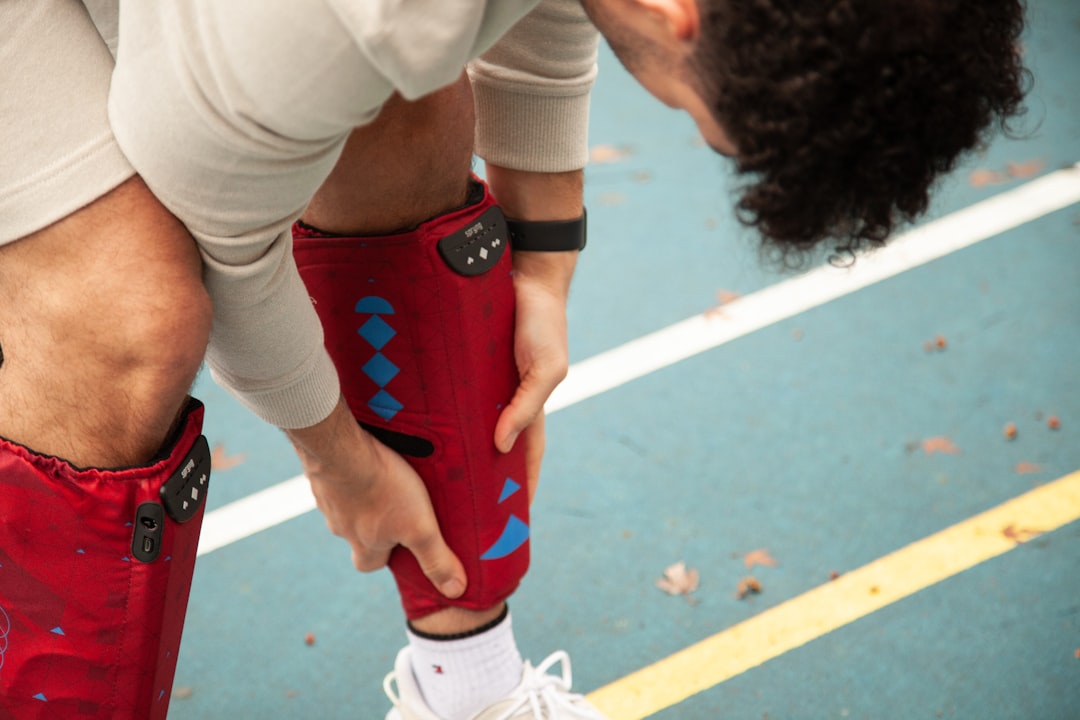Knee arthroscopy is a minimally invasive surgical procedure that allows doctors to diagnose and treat various knee conditions. It involves making small incisions in the knee and inserting a tiny camera called an arthroscope, which allows the surgeon to visualize the inside of the knee joint. This procedure has numerous benefits, including smaller incisions, less pain, faster recovery time, and reduced risk of complications compared to traditional open surgery.
After undergoing knee arthroscopy, exercise recovery plays a crucial role in regaining strength, mobility, and function in the knee. Exercise helps to improve blood circulation, reduce swelling, prevent muscle atrophy, and promote healing. It also helps to restore range of motion and strengthen the muscles around the knee joint, which are essential for stability and preventing future injuries.
Key Takeaways
- Knee arthroscopy is a common surgical procedure used to diagnose and treat knee problems.
- The healing process after knee arthroscopy can take several weeks to months, depending on the severity of the injury and the individual’s overall health.
- Factors that can affect exercise recovery after knee arthroscopy include age, weight, and the type of surgery performed.
- Patients can typically expect to return to normal activities within 4-6 weeks after knee arthroscopy, but it may take longer for more strenuous activities.
- Recommended exercises for early recovery after knee arthroscopy include gentle range-of-motion exercises and low-impact activities like walking and swimming.
Understanding the healing process after knee arthroscopy
The healing process after knee arthroscopy typically involves several stages. Initially, there is an inflammatory phase where the body responds to the surgical trauma by sending blood cells and nutrients to the area to promote healing. This phase usually lasts for a few days to a week.
Next is the proliferative phase, where new tissue begins to form and repair the damaged structures in the knee. This phase can last for several weeks and is characterized by collagen production and scar tissue formation.
Finally, there is the remodeling phase, where the newly formed tissue matures and strengthens over time. This phase can take several months to a year or more, depending on the extent of the injury and individual factors.
Factors that can affect the healing process include age, overall health, nutrition, smoking status, and any underlying medical conditions. It is important to follow post-operative instructions provided by your surgeon to ensure optimal healing.
Factors that affect exercise recovery after knee arthroscopy
Several factors can influence exercise recovery after knee arthroscopy. Age, weight, and overall health play a significant role in determining the speed and effectiveness of recovery. Younger individuals tend to recover faster due to their higher metabolic rate and better tissue healing capacity. Similarly, individuals who are overweight or have underlying health conditions may experience slower recovery due to increased stress on the knee joint and compromised healing ability.
The type and extent of the knee injury also impact exercise recovery. Minor procedures such as meniscus repair or debridement may require less intensive rehabilitation compared to more complex procedures like ligament reconstruction. The extent of the injury also affects the timeline for recovery, with more severe injuries requiring longer periods of rehabilitation.
Compliance with post-operative instructions is another crucial factor in exercise recovery. Following the prescribed rehabilitation program, including exercises, rest, and medication, is essential for optimal recovery. Failure to comply with these instructions can lead to complications, delayed healing, and increased risk of reinjury.
Typical recovery timeline for knee arthroscopy patients
The recovery timeline after knee arthroscopy can vary depending on individual factors and the specific procedure performed. However, there is a general timeline that most patients can expect.
In the first few days after surgery, patients typically experience pain, swelling, and limited mobility. During this time, it is important to rest, elevate the leg, and apply ice packs to reduce swelling.
Within the first week, patients may begin physical therapy to regain range of motion in the knee joint. This involves gentle exercises and stretches to prevent stiffness and promote healing.
By the second or third week, patients can usually start weight-bearing exercises and begin strengthening the muscles around the knee joint. This phase of rehabilitation focuses on improving stability and restoring function.
Around six weeks post-surgery, most patients can resume low-impact cardio exercises such as swimming or stationary cycling. This helps to improve cardiovascular fitness without putting excessive stress on the knee joint.
Full recovery can take several months to a year, depending on the individual and the extent of the injury. It is important to follow the guidance of your surgeon and physical therapist throughout the recovery process.
Recommended exercises for early recovery after knee arthroscopy
During the early stages of recovery after knee arthroscopy, it is important to focus on gentle exercises that promote range of motion and prevent stiffness. Range of motion exercises help to restore flexibility and mobility in the knee joint.
Some recommended range of motion exercises include heel slides, where you lie on your back and slide your heel towards your buttocks, and quad sets, where you tighten the muscles at the front of your thigh while sitting or lying down.
Strengthening exercises are also important during early recovery. These exercises help to rebuild muscle strength and stability around the knee joint. Examples of strengthening exercises include straight leg raises, where you lift your leg while lying down, and wall squats, where you lean against a wall and lower yourself into a squatting position.
Low-impact cardio exercises such as swimming or using a stationary bike can also be beneficial during early recovery. These exercises help to improve cardiovascular fitness without putting excessive stress on the knee joint.
Precautions to take during early exercise recovery after knee arthroscopy
While exercise is important for recovery after knee arthroscopy, it is crucial to take certain precautions during the early stages to avoid further injury or complications.
One important precaution is to avoid high-impact exercises such as running or jumping. These activities can put excessive stress on the knee joint and hinder the healing process. It is best to stick to low-impact exercises until your surgeon or physical therapist gives you the green light to progress.
Another precaution is to gradually increase exercise intensity. Start with gentle range of motion exercises and gradually progress to strengthening exercises as tolerated. Pushing too hard too soon can lead to pain, swelling, and delayed healing.
Listening to your body and avoiding overexertion is also important during early exercise recovery. Pay attention to any pain or discomfort and adjust your exercises accordingly. It is normal to experience some discomfort during the recovery process, but if you experience severe pain or swelling, it is important to consult with your surgeon or physical therapist.
When to start more intense exercise after knee arthroscopy
The timing for starting more intense exercise after knee arthroscopy depends on several factors, including the type of procedure performed, the extent of the injury, and individual factors such as age and overall health.
Before starting more intense exercise, it is important to consider factors such as pain levels, range of motion, and muscle strength. If you are still experiencing significant pain or have limited range of motion, it may be too early to progress to more intense exercises.
Typically, patients can start more intense exercise around six to eight weeks post-surgery. However, this timeline can vary depending on individual factors and the guidance of your surgeon or physical therapist. It is important to follow their recommendations and progress at a pace that is appropriate for your specific situation.
Common exercises for later recovery after knee arthroscopy
As you progress in your recovery after knee arthroscopy, you can start incorporating more challenging exercises to further strengthen the knee joint and improve function.
Plyometric exercises, such as jumping lunges or box jumps, can help to improve power and agility in the knee joint. These exercises involve explosive movements that require coordination and strength.
Agility exercises, such as ladder drills or cone drills, can also be beneficial for improving balance and coordination. These exercises challenge the muscles around the knee joint to respond quickly and efficiently.
Sport-specific exercises are important for individuals who want to return to a specific sport or activity. These exercises mimic the movements and demands of the sport and help to prepare the knee joint for those activities.
It is important to work with a physical therapist or qualified exercise professional to ensure proper technique and progression when performing these more advanced exercises.
Tips for preventing future knee injuries after arthroscopy
After undergoing knee arthroscopy, it is important to take steps to prevent future knee injuries. Here are some tips to help protect your knee joint:
1. Maintain a healthy weight: Excess weight puts additional stress on the knee joint, increasing the risk of injury. Maintaining a healthy weight can help reduce this risk.
2. Wear proper footwear: Wearing appropriate footwear that provides adequate support and cushioning can help to absorb shock and reduce the risk of knee injuries.
3. Strengthen the muscles around the knee: Strong muscles around the knee joint provide stability and support, reducing the risk of injury. Incorporate exercises that target the quadriceps, hamstrings, and glutes into your regular exercise routine.
4. Warm up before exercise: A proper warm-up routine helps to prepare the muscles and joints for exercise, reducing the risk of injury. Include dynamic stretches and light cardio exercises before starting your workout.
5. Listen to your body: Pay attention to any pain or discomfort during exercise and modify or stop if necessary. Pushing through pain can lead to further injury.
Importance of consulting with a physical therapist after knee arthroscopy
Working with a physical therapist after knee arthroscopy is highly beneficial for exercise recovery and injury prevention. Physical therapists are trained professionals who specialize in musculoskeletal rehabilitation and can provide personalized guidance and support throughout the recovery process.
A physical therapist can design a customized exercise program tailored to your specific needs and goals. They can guide you through proper technique, progression, and modifications as needed. They can also provide hands-on treatments such as manual therapy or modalities to help reduce pain and inflammation.
Furthermore, a physical therapist can assess your movement patterns and identify any muscle imbalances or weaknesses that may contribute to future knee injuries. They can then provide targeted exercises and strategies to address these issues and improve overall function and performance.
Exercise recovery plays a crucial role in regaining strength, mobility, and function after knee arthroscopy. It is important to follow post-operative instructions and work with a physical therapist to ensure optimal recovery. The healing process after knee arthroscopy involves several stages, and factors such as age, weight, and overall health can affect the timeline and effectiveness of recovery. By following a comprehensive exercise program that includes range of motion exercises, strengthening exercises, and low-impact cardio exercises, individuals can promote healing, prevent future injuries, and return to their desired level of activity.
If you’re recovering from knee arthroscopy and wondering when you can start exercising again, you may find this article on “Staying Healthy and Active” helpful. It provides tips and advice on how to maintain an active lifestyle while recovering from surgery. From low-impact exercises to proper nutrition, this article covers everything you need to know to stay fit and healthy during your recovery. Check it out here.







